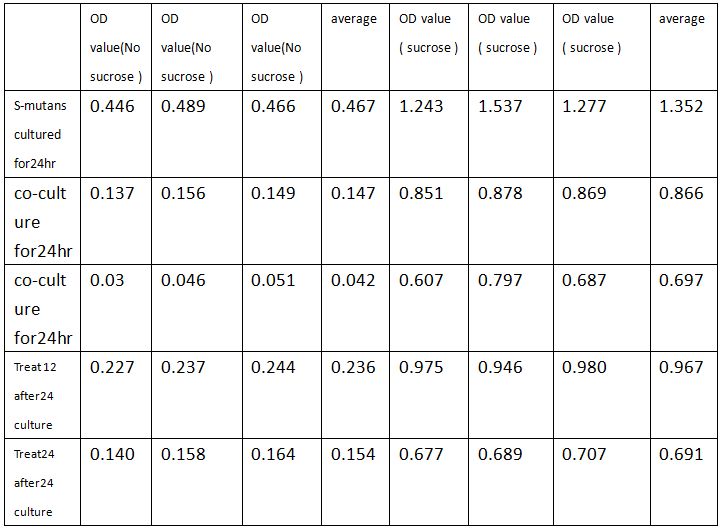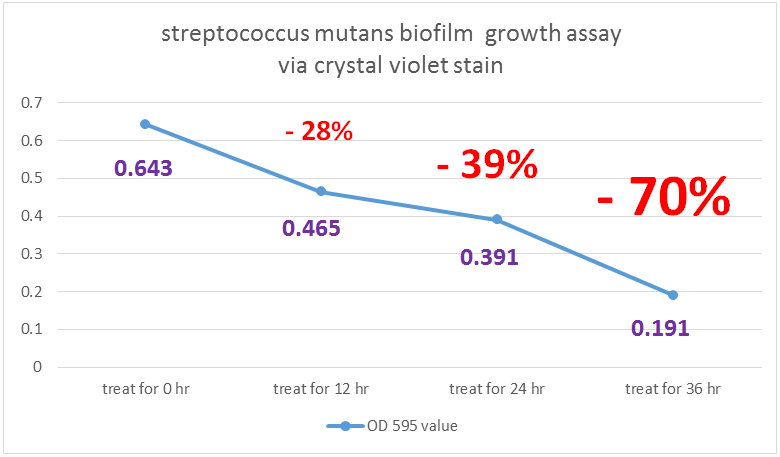Part:BBa_K1510904:Experience
This experience page is provided so that any user may enter their experience using this part.
Please enter
how you used this part and how it worked out.
Applications of BBa_K1510904
we use truncated lysostaphin coding sequence(designed by HIT-Harbin 2012 igem team) to reach our goal deplete biofilm formed by streptococcus mutans. YebF,a signal protein, would be secreted outside E.coli to make protein works more accurately.
To test whether our modified E. coli has the ability in decreasing formed biofilm, we put modified E. coli (circuit 1 and 2) to treat S. mutans for 12 hr, 24hr and 36hr. Finally, we did biofilm grow assay via crystal violet stain. biofilm grow assay:
gentally washing with ddH2O three times.
Air dried at room temperature
Stain with 500ul 0.1% crystal violet for 15min at room temperature
Add ddH2O three times to wash excess crystal violet
Add 1000 atic acid to extract crystal violet stain and wait for10 min.
Add 20 extract crystal violet stain and 800 ddH2O to do OD measurement at 595nm wavelength.

experiment1: using Hoperfusion to do biofilm growth assay.
1.S. mutans growing for 36 hr (control) OD = 0.643
2.S. mutans growing for 36 hr and treat with our modified E. coli for 12hr OD =0.465
3.S. mutans growing for 36 hr and treat with our modified E. coli for 24hr OD =0.391
4.S. mutans growing for 36 hr and treat with our modified E. coli for 36hr OD =0.191
Indicated from the graph, we could clearly see that treating our modified E. coli (transformed by Dispersin B circuit and lysostephin circuit ) have a negative impact on biofilm growth of Streptococcus mutans. As a result, we have confidence that our modified E. coli have ability to treat or influence biofilm formation.
experiment2: 24well to test biofilm decrease To test whether our modified e-coli(transformed with dispersin B and lysostephin circuit ) has influence on biofilm growth, we designed function test under two situation in 24 well.
First one is to co-culture streptococcus mutans and modified e-coli for24hr and do biofilm growth assay. The other one is to culture streptococcus mutans for 12hr and then treat with modified e-coli for 12hr and do biofilm growth assay. Also, we compare the streptococcus mutans growth situation in BHI solution with or without sucrose. We used crystal violet stain to do biofilm grow assay.

Indicated from the table, we could conclude that under no sucrose, modified e-coli has a great effect on decreasing biofilm formation. Co-culture decreasing rate is up to 64.2% and treat decreasing rate is 51.9% .On the other hand, solution with sucrose will has the bad impact on depleting biofilm, causing low decreasing rate. Overall, we could dedicate that modified e-coli has a good effect on decreasing biofilm formation or depleting biofilm.
User Reviews
UNIQbf502e113d14b443-partinfo-00000000-QINU UNIQbf502e113d14b443-partinfo-00000001-QINU

